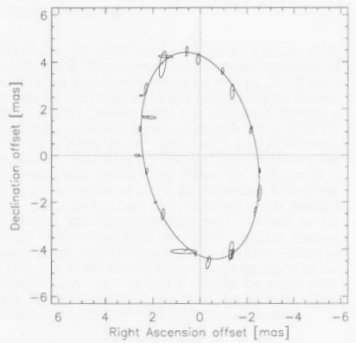
 |
Subra is a close binary star that can be resolved into its components only by using "interferometry," wherein we rely on the interfering properties of light waves. Here, the fainter secondary, Omicron Leonis B, orbits the brighter primary, Omicron Leo A every 14.5 days at a separation of 0.17 AU. The scale is in thousandths of a second of arc. The apparent ellipse is the result of the tilt of the true circular orbit against the plane of the sky. In reality, the two orbit a common center of mass that lies between them, which interferometry cannot locate, so we must rely on the relative orbit in which one star appears to go about the other. (From C. A. Hummel et al. in the Astronomical Journal, vol. 121, p. 1623, 2001.) |